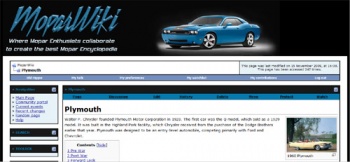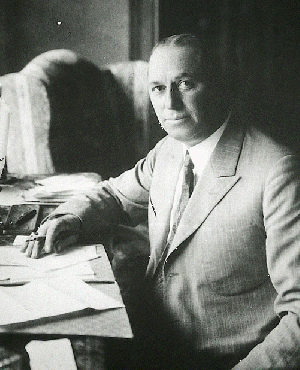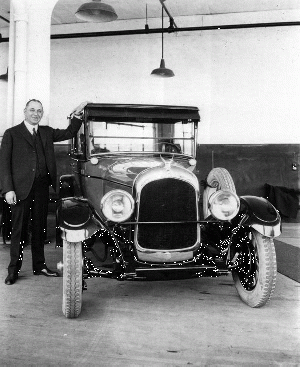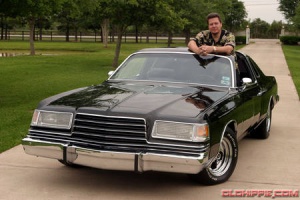Difference between revisions of "Main Page"
| Line 25: | Line 25: | ||
| '''Featured MoparWiki''' | | '''Featured MoparWiki''' | ||
|} | |} | ||
| − | ; | + | ;Walter P. Chrysler |
| − | [[Image: | + | [[Image:Chrysler.gif|thumb|300px|Walter P. Chrysler]] |
| − | |||
| − | == | + | ==Summary== |
| − | + | Walter P. Chrysler was a native of Kansas, and cut his teeth on railroading. He was the son of an engineer on the Kansas and Pacific Railroad, and was always fascinated by machinery. As a young man, he built his own working railroad model, machining his own tools in the process. When he was 17, he signed on at the Union Pacific shops as an apprentice, for a nickel an hour. Mechanical engineering became young Walt Chrysler's life, not his profession. | |
| − | + | After he got his journeyman's certificate, he took a job in the Rio Grande & Western roundhouse in Salt Lake City. He got married and began studying with the International Correspondence School. He steadily moved up through the industry. | |
| − | + | After a bit of time, the superintendent of motive power of the whole Chicago & Great Western system was a new man named Chrysler. "W.P." they called him. During his Great Western period Mr. Chrysler lived in Oelwein, Iowa. His mechanical curiosity was piqued by the new ‘horseless carriages’ he’d see traversing the town streets. | |
| − | + | He went to the 1905 Chicago automobile show, where he saw a beautiful auto that he had to have. It was called a ‘Locomobile’. The price was $5,000 cash. Chrysler had only $700 in the bank, but that did not hold him back. He borrowed $4,300 and shipped it home. He spent months with his first car, tearing it down and reassembling it several times before he even learned to drive it! Chrysler decided that when the time was right, he would need to improve these things. | |
| − | + | At 33, machinist/manager WP joined on with the American Locomotive Company, where he swiftly rose through the ranks. He was assigned to the position of Assistant Works Manager at the sprawling ALCO Pittsburgh plant, which he quickly transformed into a moneymaker. It was in this position that WP was first noticed by one of the directors of ALCO, James J. Storrow, who would soon the president of General Motors. | |
| − | + | James Storrow, the president of GM, remembered the young Chrysler, and introduced him to Charlie Nash, then the president of Buick. After touring the Buick works, Nash could offer WP only $6000 a year, half of WP’s $12000 a year ALCO salary. Chrysler did not even hesitate! He immediately accepted the Buick position. | |
| − | + | It was 1911, and Walter P. Chrysler was in the automobile business! | |
| − | + | Over the next few years, WP built Buick into a power to be reckoned with, with Nash at the helm. In 1916, however, William Crapo Durant used the power of his upstart Chevrolet Company to leverage the presidency of General Motors. Nash would not be welcome under Durant, and Nash and Chrysler were a team. | |
| − | + | Nash purchased another auto manufacturer, in Kenosha, Wisconsin, and created the Nash Motors Company, which would later become [[American Motors Corporation|American Motors]]. It was assumed that Chrysler would join him at the helm of this new company. | |
| − | + | Durant had other ideas, however. He offered WP a salary of $10,000 a month, plus a yearly bonus of half-a-million dollars, in either GM stock or cash. Chrysler accepted, on the condition that he be allowed to run Buick with no interference from other GM companies. WP was now the president of Buick Motors, a job he would hold until 1919, when friction between Chrysler and Durant would come to a head. By 1919, WP had earned $ 10 million worth of GM stock, which he surrendered to GM for cash. Chrysler would eventually use this money to seed his own automobile company. | |
| − | + | The only thing WP Chrysler lacked at this time was experience in automotive finance. In 1920, Willys-Overland found itself in financial trouble. John N. Willys had created Willys Corporation as a holding company and proceeded to acquire such firms as Wilson Foundry, Curtiss Aeroplane, Moline Plow, Electric Autolite, New Process Gear. Chase Securities Company had millions tied up in the Willys situation, and hired Walter Chrysler to get their money back. | |
| − | + | WP thus became executive vice president at a salary of one million a year. While there, Chrysler came across plans to develop a new Willys Six at the former Duesenberg plant in New Jersey. After determining the new car was inferior to its proposed competitors, Chrysler ordered a new car be developed. To head the new project, Carl Breer, Fred Zeder and Owen Skelton were hired. The new car was to be the Chrysler Six. The Willys Corporation went into receivership in 1921 and Chrysler tried to purchase the plant and car at a receiver's sale but was not successful. W.C. Durant had the successful bid and the new Chrysler Six was reworked to become the Flint 55. | |
| − | + | During the same time period, WP agreed to help Chase Securities at Maxwell Motor Company, a firm that owed Chase $26 million. Chrysler improved the Maxwell, there were thousands of unsold cars, and sold them off at a profit of $5 per car. Maxwell and Chalmers were merged into one firm and WP became president of the new firm in 1923. | |
| − | + | [[Image:FIRST CA.gif|thumb]] | |
| + | During 1923 Breer, Skelton and Zeder were hired to develop a new car to replace the Chalmers. The result was the Chrysler [[Model B]], appearing in January, 1924. It was dubbed the Model B in memory of the stillborn Chrysler designed at Willys. | ||
| + | Within the [[Maxwell]] Motors framework, the new Chrysler replaced the Chalmers and Chrysler began gaining control of the company. Sales were strong and in June, 1925 the [[Chrysler (Company)| Chrysler Corporation]] was formed to takeover the Maxwell company. In the summer of 1925 the new 1926 models were introduced with the Maxwell reworked to become the [[Chrysler Four]]. The [[Chrysler Six became the [[Chrysler 70]] and a new [[Chrysler 60]] was introduced along with the [[Imperial]], model 80. | ||
| − | [[Plymouth|More]] | + | In early July of 1928, Walter P. Chrysler offered the public a new automobile called the [[Plymouth]] and new six cylinder car, the [[DeSoto]], priced just above the Plymouth. At the end of that same month, [[Dodge Brothers]] was acquired from Dillon, Read and all DB stockholders. Dodge Brothers, Inc, included [[Graham Brothers]], a large truck company. Almost incidentally, he brought out a new line of commercial cars--the [[Fargo]] "Packet" and "Clipper”, based on Plymouth and DeSoto mechanicals. |
| + | |||
| + | Early in autumn of 1928 came the news that Walter P. Chrysler was going to build the world's tallest skyscraper, a 68-story colossus towering more than 800 feet above Manhattan. When it opened to the public on May 27, 1930, at 405 Lexington Avenue, the [[Chrysler Building]] was the tallest building in the world. This only lasted for several months until the Empire State Building was completed | ||
| + | |||
| + | During the Great Depression of the 30’s, while many other companies would fail and disappear forever, the Chrysler Corporation would not only survive, but thrive. Chrysler did this by dropping the prices of his cars, selling them at for only a small profit. He also had maintained the research and development that made Chrysler products famous during these lean times. | ||
| + | |||
| + | ==Personal Data== | ||
| + | |||
| + | *Full Name: Walter Percy Chrysler | ||
| + | *DOB: April 2, 1875 | ||
| + | *Place of Birth: Wamego, Kansas | ||
| + | *DOD: August 18, 1940 | ||
| + | *Place Interned: Sleepy Hollow Cemetery Westchester County, NY | ||
| + | *Spouse: Della Forker | ||
| + | *Children: | ||
| + | ** Thelma Irene Chrysler was born in 1902 - August 20, 1957 | ||
| + | ** Bernice Chrysler 1906 - ?? | ||
| + | ** Walter P. Chrysler, Jr. May 27, 1909 - September 17, 1988 | ||
| + | ** Jack Forker Chrysler January 7, 1912 -?? | ||
| + | |||
| + | |||
| + | [[Walter P. Chrysler|More]] | ||
| style="width:50%;background:#EBF8FF; border:1px solid #004E7C; color:black;align:center;vertical-align:top" | | | style="width:50%;background:#EBF8FF; border:1px solid #004E7C; color:black;align:center;vertical-align:top" | | ||
Revision as of 16:43, 28 October 2012
|
SummaryWalter P. Chrysler was a native of Kansas, and cut his teeth on railroading. He was the son of an engineer on the Kansas and Pacific Railroad, and was always fascinated by machinery. As a young man, he built his own working railroad model, machining his own tools in the process. When he was 17, he signed on at the Union Pacific shops as an apprentice, for a nickel an hour. Mechanical engineering became young Walt Chrysler's life, not his profession. After he got his journeyman's certificate, he took a job in the Rio Grande & Western roundhouse in Salt Lake City. He got married and began studying with the International Correspondence School. He steadily moved up through the industry. After a bit of time, the superintendent of motive power of the whole Chicago & Great Western system was a new man named Chrysler. "W.P." they called him. During his Great Western period Mr. Chrysler lived in Oelwein, Iowa. His mechanical curiosity was piqued by the new ‘horseless carriages’ he’d see traversing the town streets. He went to the 1905 Chicago automobile show, where he saw a beautiful auto that he had to have. It was called a ‘Locomobile’. The price was $5,000 cash. Chrysler had only $700 in the bank, but that did not hold him back. He borrowed $4,300 and shipped it home. He spent months with his first car, tearing it down and reassembling it several times before he even learned to drive it! Chrysler decided that when the time was right, he would need to improve these things. At 33, machinist/manager WP joined on with the American Locomotive Company, where he swiftly rose through the ranks. He was assigned to the position of Assistant Works Manager at the sprawling ALCO Pittsburgh plant, which he quickly transformed into a moneymaker. It was in this position that WP was first noticed by one of the directors of ALCO, James J. Storrow, who would soon the president of General Motors. James Storrow, the president of GM, remembered the young Chrysler, and introduced him to Charlie Nash, then the president of Buick. After touring the Buick works, Nash could offer WP only $6000 a year, half of WP’s $12000 a year ALCO salary. Chrysler did not even hesitate! He immediately accepted the Buick position. It was 1911, and Walter P. Chrysler was in the automobile business! Over the next few years, WP built Buick into a power to be reckoned with, with Nash at the helm. In 1916, however, William Crapo Durant used the power of his upstart Chevrolet Company to leverage the presidency of General Motors. Nash would not be welcome under Durant, and Nash and Chrysler were a team. Nash purchased another auto manufacturer, in Kenosha, Wisconsin, and created the Nash Motors Company, which would later become American Motors. It was assumed that Chrysler would join him at the helm of this new company. Durant had other ideas, however. He offered WP a salary of $10,000 a month, plus a yearly bonus of half-a-million dollars, in either GM stock or cash. Chrysler accepted, on the condition that he be allowed to run Buick with no interference from other GM companies. WP was now the president of Buick Motors, a job he would hold until 1919, when friction between Chrysler and Durant would come to a head. By 1919, WP had earned $ 10 million worth of GM stock, which he surrendered to GM for cash. Chrysler would eventually use this money to seed his own automobile company. The only thing WP Chrysler lacked at this time was experience in automotive finance. In 1920, Willys-Overland found itself in financial trouble. John N. Willys had created Willys Corporation as a holding company and proceeded to acquire such firms as Wilson Foundry, Curtiss Aeroplane, Moline Plow, Electric Autolite, New Process Gear. Chase Securities Company had millions tied up in the Willys situation, and hired Walter Chrysler to get their money back. WP thus became executive vice president at a salary of one million a year. While there, Chrysler came across plans to develop a new Willys Six at the former Duesenberg plant in New Jersey. After determining the new car was inferior to its proposed competitors, Chrysler ordered a new car be developed. To head the new project, Carl Breer, Fred Zeder and Owen Skelton were hired. The new car was to be the Chrysler Six. The Willys Corporation went into receivership in 1921 and Chrysler tried to purchase the plant and car at a receiver's sale but was not successful. W.C. Durant had the successful bid and the new Chrysler Six was reworked to become the Flint 55. During the same time period, WP agreed to help Chase Securities at Maxwell Motor Company, a firm that owed Chase $26 million. Chrysler improved the Maxwell, there were thousands of unsold cars, and sold them off at a profit of $5 per car. Maxwell and Chalmers were merged into one firm and WP became president of the new firm in 1923. During 1923 Breer, Skelton and Zeder were hired to develop a new car to replace the Chalmers. The result was the Chrysler Model B, appearing in January, 1924. It was dubbed the Model B in memory of the stillborn Chrysler designed at Willys. Within the Maxwell Motors framework, the new Chrysler replaced the Chalmers and Chrysler began gaining control of the company. Sales were strong and in June, 1925 the Chrysler Corporation was formed to takeover the Maxwell company. In the summer of 1925 the new 1926 models were introduced with the Maxwell reworked to become the Chrysler Four. The [[Chrysler Six became the Chrysler 70 and a new Chrysler 60 was introduced along with the Imperial, model 80. In early July of 1928, Walter P. Chrysler offered the public a new automobile called the Plymouth and new six cylinder car, the DeSoto, priced just above the Plymouth. At the end of that same month, Dodge Brothers was acquired from Dillon, Read and all DB stockholders. Dodge Brothers, Inc, included Graham Brothers, a large truck company. Almost incidentally, he brought out a new line of commercial cars--the Fargo "Packet" and "Clipper”, based on Plymouth and DeSoto mechanicals. Early in autumn of 1928 came the news that Walter P. Chrysler was going to build the world's tallest skyscraper, a 68-story colossus towering more than 800 feet above Manhattan. When it opened to the public on May 27, 1930, at 405 Lexington Avenue, the Chrysler Building was the tallest building in the world. This only lasted for several months until the Empire State Building was completed During the Great Depression of the 30’s, while many other companies would fail and disappear forever, the Chrysler Corporation would not only survive, but thrive. Chrysler did this by dropping the prices of his cars, selling them at for only a small profit. He also had maintained the research and development that made Chrysler products famous during these lean times. Personal Data
More |
BK (short for Big Kahuna -- a name friends gave him back in the early 90s) is the Administrator of MoparStyle, which he started in 2001. He's a semi-retired business executive/owner who now spends with his family, drag racing, and maintaining a slew of web sites and a gaggle of collector cars. Childhood Eldest of five boys and three girls who grew up in poverty living in a 2 bedroom apartment. Born in Michigan, but moved to Texas in 1961. Moved again to New Jersey in 1966, New York in 1970, and back to Texas after completion of Military service. Grew up with very little supervision, as his family was so large. His father always worked three minimum wage jobs concurrently, and his mother was too overwhelmed to keep up with all of the kids by herself -- so Dave pretty much grew up on the streets -- getting into a lot of trouble with the law as a kid. He always had a job of some type as a kid, from paper routes to washing dishes. Education He was a D/F student until leaving high school by mutual agreement at 16. Later attended various colleges in the evenings under the GI Bill, with a focus on business and computer science Military Service Dave enlisted in the USAF in 1972, shortly after turning 17, and was the youngest to be serving at the time he arrived to Basic Training in San Antonio, Texas. He spent three years active duty driving trucks, and exchanged his last year active for two years Active Reserves (under Palace Chase) to teach others to drive trucks. Dave spent the next ten years attending college in the evenings under the GI Bill. He is a service connected Vietnam Era disabled Veteran. Employment Career After he completed his military service, he (in order) drove taxi, Tractor-trailer, and dump truck; laid blacktop, roofed, and repo'd vacuum cleaners; was a bill collector, a carpet cleaning salesman, and a draftsman; a postage equipment repairman, a mailroom equipment salesman, and a computer repairman; a computer salesman, Executive VP of two large collection agencies, and owned a collections agency; owned a distress debt buying business, a software company, and a web hosting company; owned an race engine building company, and he now designs web sites. Dave and his eldest son (Dallas) recently started a Motorcycle Tour business by the name of Texas Motorcycle Excursions. Favorite Quote A democracy cannot exist as a permanent form of government. It can only exist until the voters discover that they can vote themselves largesse from the public treasury. From that moment on, the majority always votes for the candidates promising the most benefits from the public treasury with the result that a democracy always collapses over loose fiscal policy, always followed by a dictatorship. The average age of the world's greatest civilizations has been 200 years. Great nations rise and fall. The people go from bondage to spiritual truth, to great courage, from courage to liberty, from liberty to abundance, from abundance to selfishness, from selfishness to complacency, from complacency to apathy, from apathy to dependence, from dependence back again to bondage. Favorite Mopar
Favorite Movie
Favorite Book
Favorite Recent TV Series
Favorite TV Show as a kid
Favorite Song
Favorite Singer
Favorite Band
Favorite Album
Favorite Sports Team
Favorite Charity
Favorite President
Least Favorite President I'd like to party hard all night with
Biggest Babe Ever
More |
|
|
|
|
|
|
|



